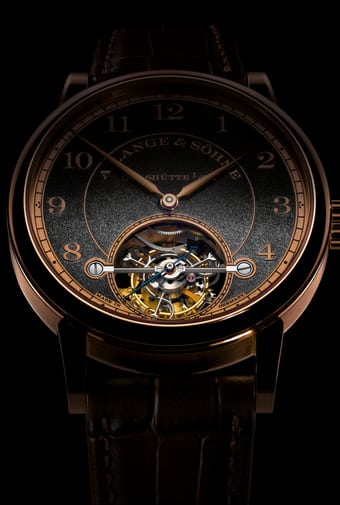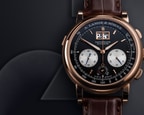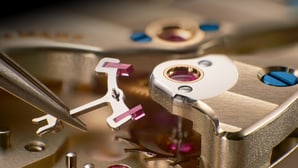Beyond precision
The tourbillon is one of the most sophisticated complications in precision watchmaking. The fascinating mechanism devised to increase rate accuracy continuously rotates the balance about its own axis, thus minimising the influence of gravity on the oscillation system.
The masterpieces crafted in our manufacture by far transcend its conventional implementation. Launched in 1994, the TOURBILLON “Pour le Mérite” was the first wristwatch to combine a tourbillon with a fusée-and-chain transmission. More than 30 years ago, this highly complex paragon of timekeeping was testimony of A. Lange & Söhne’s ambition to forge new paths in traditional watchmaking. Since then, the tourbillon has invariably played a leading part, symbolising the innovative powers of the manufacture.
When complicated is not complicated enough
What once began with the TOURBILLON “Pour le Mérite”, has become an ongoing development. Our watchmakers have since constantly evolved the tourbillon with revolutionary technical solutions and combined it with additional elaborate complications. Some of the more prominent tourbillon models presented from then on include:
CABARET TOURBILLON and 1815 TOURBILLON
The tourbillon mechanism was invented more than 200 years ago, with one remaining decisive drawback: the tourbillon could not be stopped at will, making it impossible to precisely set the watch. In 2008, Lange introduced the CABARET TOURBILLON, the first tourbillon watch boasting the stop-seconds device, patented at that time.
In 2014, the Lange product developers took matters a step further with the 1815 TOURBILLON: they combined the stop-seconds device with the ZERO-RESET function. When the crown is pulled, the seconds hand is not only stopped, it jumps to zero with lightning speed. Therefore, the minute hand can be precisely aligned with a minute marker and the watch can be set with one-second accuracy ‒ a degree of precision that is still a rarity in tourbillon watches.
LANGE 1 TOURBILLON PERPETUAL CALENDAR
The LANGE 1 TOURBILLON PERPETUAL CALENDAR unites two grand complications with the distinctive face of the LANGE 1. Thanks to the ingenious arrangement of the instantaneously switching calendar displays outside the hour and minute circle, the dial is a well-organised model of clarity, making all displays instantly readable. The technical perfection of the tourbillon with stop seconds can be observed through the sapphire-crystal caseback.
TOURBOGRAPH PERPETUAL “Pour le Mérite”
In terms of design, construction and artisanal finish, the TOURBOGRAPH PERPETUAL “Pour le Mérite” represents a pinnacle of classic precision watchmaking ‒ thanks to the one-of-a-kind combination of no less than five complications. Emblematic of Glashütte watchmaking artistry, the manufacture calibre L133.1 is artisanally finished to a sublime standard. It incorporates a fusée-and-chain transmission, a tourbillon, a chronograph with rattrapante function and a perpetual calendar.
Peerless artisanship
The tourbillon movements crafted in our manufacture represent highlights of German precision watchmaking, also in terms of aesthetic appeal. Every calibre is embellished with numerous finishing and decoration techniques; with only few exceptions, these are performed manually. They include engraving cocks and bridges as well as polishing chamfers and a variety of artistic decorations.
Elaborate black polish is applied to the tourbillon bridge and the upper section of the cage, constituting eye-catching focal points. This technique involves using special abrasive pastes and uniformly sliding the workpiece with just the right pressure across a tin plate by hand until the surface has a mirror gloss when viewed from a certain angle. And from another perspective, it has a jet-black sheen.
Additionally, chamfering the acute internal angles of the tourbillon cage presents a particular challenge. This rare finishing technique can only be carried out by hand using a special sharp tool. These details alone involve several days of work for our finishers.
Complications



Explore further




Exclusive insights into the world of fine watchmaking
Experience A. Lange & Söhne’s fascinating heritage, unique stories and exquisite timepieces by subscribing to our newsletter.
How can we be of service?
Whether you are in search of a specific model, have questions out of interest or need a service request for your timepiece – we are delighted to help you. We are at your service by phone, email or in one of our boutiques.
















